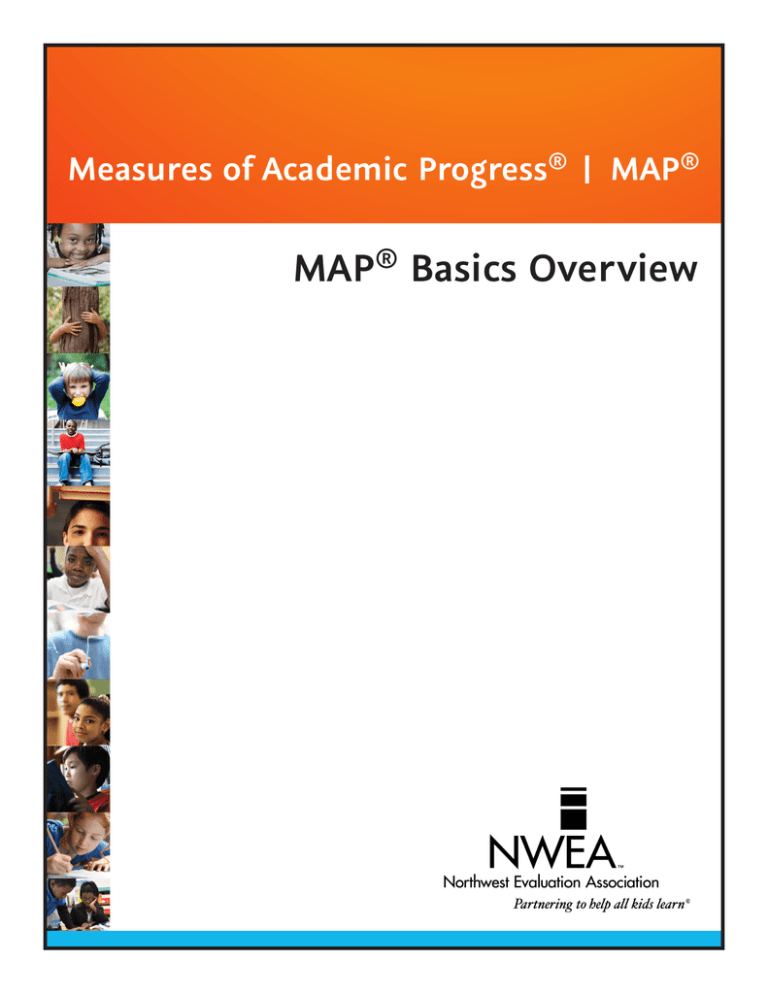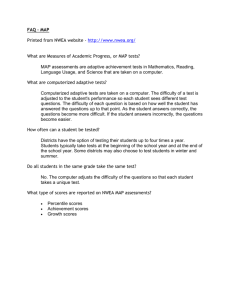
Measures of Academic Progress® | MAP®
MAP Basics Overview
®
Copyright
©2012 Northwest Evaluation Association™
All rights reserved. No part of this manual may be reproduced or utilized in any form or by any means,
electronic or mechanical, including photocopying, recording, or by any information storage and retrieval
system, without written permission from NWEA.
Trademarks
Measures of Academic Progress, MAP, and DesCartes: A Continuum of Learning are registered trademarks
of NWEA in the U.S. or other countries.
Lexile® is a trademark of MetaMetrics, Inc., and is registered in the United States and abroad.
The names of other companies and their products mentioned are the trademarks of their respective owners.
Measures of Academic Progress® (MAP®) Overview
The Northwest Evaluation Association™ (NWEA™) computerized adaptive assessments give educators the information they need to improve teaching and learning. Educators use the growth and achievement data from MAP
assessments to develop targeted instructional strategies and plan school improvement. Results help educators
make student-focused, data-informed decisions. MAP assessments are available in Reading, Language Usage,
Mathematics, and Science.
Our Mission is Partnering to help all kids learn®
We help schools create a culture that uses data to make instructional decisions.
We provide training, professional development, and support.
We conduct research to improve learning.
Our purpose is growth and improvement of learning.
We promote the instructional needs of every child, creating the most growth possible.
The Classroom Experience
Consider the students in a typical sixth grade classroom. Imagine each “x” in the diagram below represents a
student. Miguel is a student who performs quite well, excelling in reading and always scoring well on traditional
standardized tests. Martin, on the other hand, is a student who struggles to keep up with the academic demands
in a typical sixth grade classroom. Imagine Martin is taking a test. A traditional test would present Martin with
questions appropriate for most sixth graders. As an under performer, Martin might only be able to comprehend
the vocabulary in a few questions. He would quickly become frustrated and might not put forth his best effort. He
could even spend the remainder of the test guessing at answers, without attempting to even read the questions.
The results from this traditional test would provide Martin’s teacher with little information that could be used
to help him. Results would indicate that he was performing below the sixth-grade level, something his teacher
already knew.
MAP® Basics Overview
NWEA.org 1
The MAP® Experience
Instead of a traditional standardized test, Martin is taking the NWEA MAP computerized adaptive assessment.
When Martin sits down at the computer for the first time, the computer will select and display a question that is
appropriate for a typical sixth grader. From here on out, the computer will select questions specifically for Martin
that depend on how he performs on all of the previous questions.
Martin more than likely misses the first question because it is a question that is appropriate for a typical
sixth grader. The computer then selects an easier question from the next goal strand and displays it.
Martin misses this next question as well. Based on his two responses so far, the computer displays another
easier question.
This question is appropriate for Martin, and he answers it correctly. Based on his three responses so far, the
computer chooses another question.
Each time Martin answers a question, the computer scores all the questions displayed so far to select the
next question.
The computer continues to select questions, cycling through the goal strands, until Martin finishes the assessment.
The score is immediately available to Martin and his teacher and is reported in a Rasch unIT (RIT). Martin
scored a 195 RIT on his Reading assessment.
Once Martin begins the assessment, he sees a variety of questions that assess his knowledge across all of the goal
performance areas. Martin simply selects a response and proceeds to the next question.
Sample MAP® Assessment Computer Screens
Sample question from a Mathematics test.
MAP® Basics Overview
Sample question from a Reading test.
NWEA.org 2
At the end of the assessment, a score screen displays data from that assessment.
Martin Newberry
Congratulations, you finished the test.
Measurement Scale:
Reading
Overall Score: 195
Lexile® Range: 429-579
Strategies,
Goal Name: Reading
Comprehending Literary Texts
Goal Score: 193
Goal Range: 188-200
Informative
Goal Name: Comprehending
and Persuasive Texts
Goal Score: 201
Goal Range: 195-207
Sample End-of-Test Score Screen: Client-Server MAP
Relationships and
Goal Name: Word
Meaning
Goal Score: 195
Goal Range: 190-202
The total test time was: 00:31:57
Date: 12-01-2011 Test Name: MAP: Reading 6+ CO 2009
Lexile® is a trademark of MetaMetrics, Inc., and is registered
in the United States and abroad.
Sample End-of-Test Score Screen: Web-Based MAP
The score screen provides an overall RIT score plus information about each goal performance area. This information can be directly related to DesCartes: A Continuum of Learning®, an instructional tool that allows educators to
translate MAP scores into skills and concepts a student may be ready to learn. Reading assessments also report a
student’s Lexile® Range. The Lexile® Range is a score resulting from a correlation between the NWEA RIT score and
the MetaMetrics® Lexile scale. More information on The Lexile® Framework for Reading is provided at the end of
this document.
Features of MAP® Assessments
The assessments challenge every student. Students are not expected to get every question right or every
question wrong.
They are dynamically built based on students’ achievement levels and give accurate, reliable information for
every student.
They are untimed. Students should be given as much time as needed to complete a test, as long as they are
making progress.
Assessments are given for internal accountability. They give educators information about students within
the district, school, or classroom and are used by educators for their own internal purposes. Even though
NWEA provides external norms, these are for a general reference.
They measure growth and show how students are progressing, because the data can be looked at historically and are consistent from season to season.
Results are received immediately and display at the end of the assessment.
Students can take MAP assessments up to four times a year in Reading, Language Usage, and Mathematics
in order to monitor their growth. Science assessments can be given up to three times a year.
MAP® Basics Overview
NWEA.org 3
Meeting the Needs of All Students
As educators, we start with a curriculum scale. In
reading, for example, children come to us knowing
that letters have sounds attached to them. We want
them to leave us able to read college-level materials.
How do we do this? We assign curriculum that will
be taught at each grade level.
We can assume that most schools are graded. That
is, students are divided into 13 grade-level groups.
Curriculum is divided in accordance with these grade
levels and is articulated upward by skills. In reality, however, we have students who are performing
above, at, and below this grade-level structure. So
we have to ask ourselves how we foster growth for
all of these students, no matter where they are performing along our curriculum scale.
The answer to that question lies in knowing where every student is performing and delivering instruction directly
related to that performance level. The MAP system can help us with both by giving us scores that are accurate and
reliable.
The RIT scale measures student achievement and growth. It is an equal-interval scale, like feet and inches, so
scores can be added together to calculate accurate class or school averages. The scores make it possible to follow a
student’s educational growth from year to year.
DesCartes: A Continuum of Learning®
DesCartes orders specific Reading, Language Usage, Mathematics, and Science skills and concepts by achievement level. The skills and concepts align to the content of your state standards. Please visit the Our Research
section of NWEA.org to
find the study for your
state. For easy reference,
skills and concepts are
organized according to
the framework of your
state’s content standards
and grouped within the
continuum in ten-point
RIT bands. You may access DesCartes from the
Reports Site or MAP
Administration and
Reporting Center (MARC).
MAP® Basics Overview
NWEA.org 4
MAP® Assessments Provide Students’ Instructional Levels
MAP assessments are based on a continuum of skills in Mathematics, Reading, Language Usage, and Science, from
low skill levels to high skill levels. We can consider them to be one long assessment in a particular subject, rather
than a series of shorter assessments that assess students over specific criteria at various grade levels. MAP assessments are not tests that determine mastery. Rather, MAP assessments provide teachers with students’ instructional levels. They provide a road map for determining where each student is performing relative to local or state
standards, curriculum, or other criteria.
Uses of MAP® Assessments
Assessments can be administered to new students as they enter the district to determine appropriate instructional levels.
Assessments can be given before parent conferences if a measure is needed at that time.
Student growth can be monitored throughout the school year and from year to year.
Winter assessment is useful to further monitor progress and determine if instruction needs to be adjusted.
MAP data provides information to help inform instructional decisions.*
Student progress in special programs such as Title I can be monitored by using MAP data.
* The Comparative Data to Inform Instructional Decisions document is available at NWEA.org > Partner Support.
Normative Data
Educators use data from the most recent RIT Scale Norms Study to help determine what is typical, i.e., students
scoring at the 50th percentile in the Norms Study. We use the word “typical” rather than “should be” or “expected,” as we treat each student as a unique individual. The RIT Scale Norms Study may be accessed from the Reports
Site and MARC.
This table was extracted from the Normative Data document found at
NWEA.org > Partner Support.
MAP® Basics Overview
NWEA.org 5
Growth Norms
From the RIT Scale Norms Study, we know that low-performing students and high-performing students don’t tend
to grow at the same rate. A simple grade-level growth average doesn’t capture this information and may lead us
to inaccurate decisions about students.
As shown in the table below, we can see that students scoring a 160 fall RIT showed an average (mean) RIT
growth of 11.6 after 28 weeks of instruction. Students scoring a 210 in the fall, showed an average RIT growth of
7.1 after 28 weeks of instruction.
Grade 3 Reading: 4th Week of Instruction to 28th Week of Instruction
Starting RIT
160
170
180
190
200
210
220
Mean Growth
11.6
10.7
9.8
8.9
8.0
7.1
6.2
From the RIT Scale Norms Study, Grade 3 Reading
NWEA™ Resources
NWEA.org > Partner Support
For the latest updates, documents and resources relating to MAP Administration, our partner support services,
and other NWEA products and services, please visit the Partner Support section of NWEA.org.
NWEA.org > SPARK Community
SPARK is an online community of educators coming together to ignite kid-centric education. SPARK members
can learn from one another and share what’s working. The SPARK Community has forums and blogs where you
can discuss ideas with fellow educators, NWEA staff, and leaders throughout the education community. You can
discover and share lesson plans and other resources for using MAP data to its fullest extent. Visit NWEA.org to
register for the SPARK Community.
Other Web Resources
Along with reading scores, NWEA also reports Lexile® ranges. With its unique reading scale and corresponding
tools, The Lexile® Framework for Reading helps educators and parents select reading materials that appropriately
challenge students, thereby guiding the development of stronger reading skills. More information can be found at
Lexile.com.
Find NWEA on Facebook or follow us at twitter.com/NWEA to get updates from NWEA and the SPARK Community
and stay current with the latest education headlines.
MAP® Basics Overview
NWEA.org 6
Northwest Evaluation Association™
121 NW Everett Street, Portland, OR 97209
503.624.1951 | NWEA.org | Revised 1/2012 |
©2012 Northwest Evaluation Association



